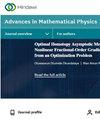Quasilinear Hyperbolic Systems Applied to Describe the Magnetohydrodynamic Nanofluid Flow
IF 1.1
4区 物理与天体物理
Q3 PHYSICS, MATHEMATICAL
引用次数: 0
Abstract
This study examines the flow of hyperbolic nanofluid over a stretching sheet in three dimensions. The influence of velocity slip on the flow and heat transfer properties of a hyperbolic nanofluid has been investigated. The partial differential equations for nanoparticle solid concentration, energy, and motion were turned into ordinary differential equations. Nanoparticle mass fluxes at boundaries are assumed to be zero, unlike surface concentrations. The influence of the main parameters on flow characteristics, surface friction coefficients, and the Nusselt number has been visualized. The results suggest that Brownian motion has a negligible impact on the heat transfer rate. The ratio of the elastic force to the viscosity force was found to decrease the fluid velocity. The resulting thermophysical properties of nanofluids are in agreement with previous research. The present findings can be used to expand the potential for using nanofluids as a coolant in critical thermophysical and industrial installations.拟线性双曲系统在描述磁流体动力学纳米流体流动中的应用
这项研究考察了双曲型纳米流体在拉伸片上的三维流动。研究了速度滑移对双曲型纳米流体流动和传热特性的影响。将纳米粒子固体浓度、能量和运动的偏微分方程转化为常微分方程。与表面浓度不同,假设边界处的纳米粒子质量通量为零。主要参数对流动特性、表面摩擦系数和努塞尔数的影响已经可视化。结果表明,布朗运动对传热速率的影响可以忽略不计。发现弹性力与粘性力的比值降低了流体速度。由此产生的纳米流体的热物理性质与之前的研究一致。目前的发现可用于扩大在关键热物理和工业装置中使用纳米流体作为冷却剂的潜力。
本文章由计算机程序翻译,如有差异,请以英文原文为准。
求助全文
约1分钟内获得全文
求助全文
来源期刊

Advances in Mathematical Physics
数学-应用数学
CiteScore
2.40
自引率
8.30%
发文量
151
审稿时长
>12 weeks
期刊介绍:
Advances in Mathematical Physics publishes papers that seek to understand mathematical basis of physical phenomena, and solve problems in physics via mathematical approaches. The journal welcomes submissions from mathematical physicists, theoretical physicists, and mathematicians alike.
As well as original research, Advances in Mathematical Physics also publishes focused review articles that examine the state of the art, identify emerging trends, and suggest future directions for developing fields.
 求助内容:
求助内容: 应助结果提醒方式:
应助结果提醒方式:


